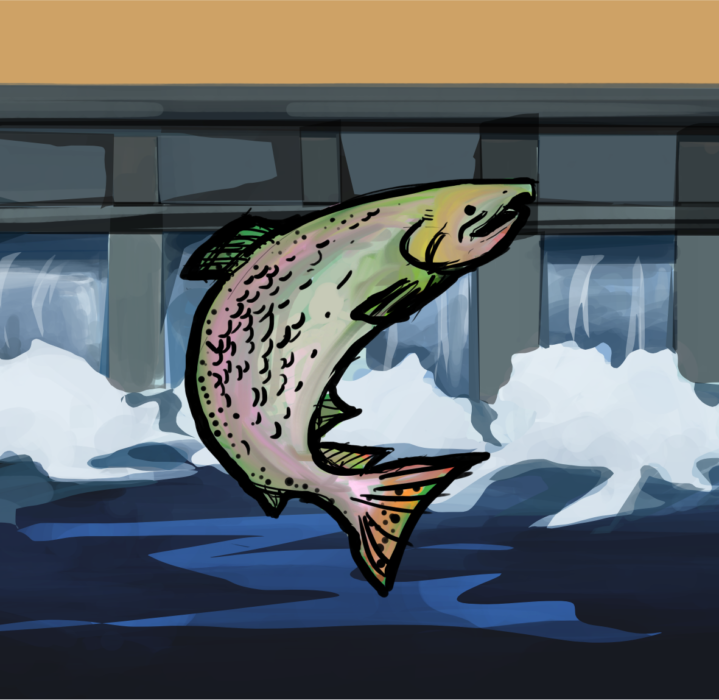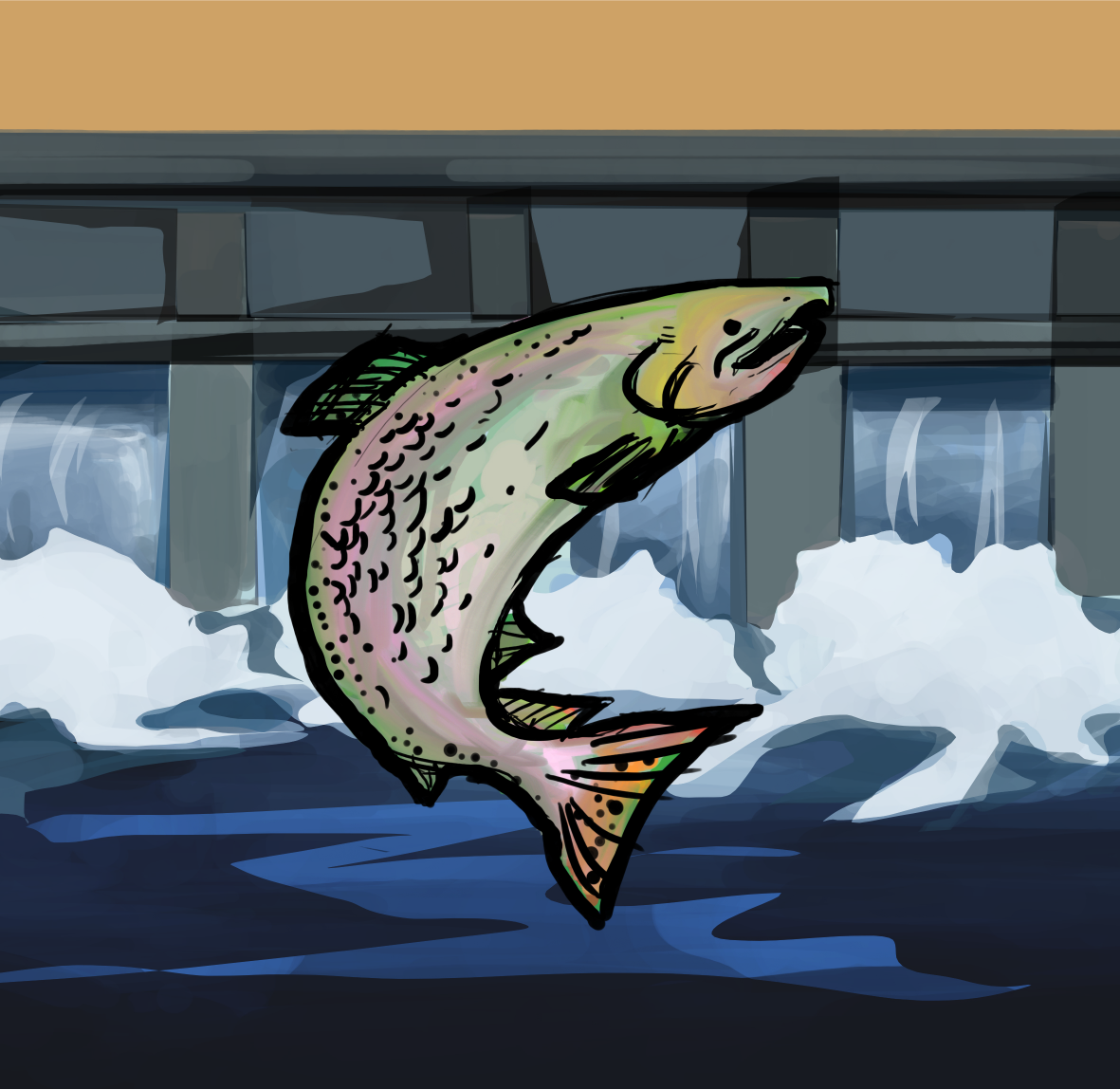
Last month, Idaho Congressman Mike Simpson stood before an audience of anglers and farmers, conservationists and industrialists, tribal members and hydropower officials. The Republican laid out the stark reality that had brought them, at last, together.
“All of Idaho’s salmon runs are either threatened or endangered,” he said. “Look at the number of returning salmon, and the trend line is not going up. It is going down.”
Hosted by the Andrus Center for Public Policy, the April 23 conference marked the first time in decades that stakeholders gathered to collaboratively discuss interconnected challenges: the threat of extinction of wild salmon in the Columbia River basin and the financial viability of the Bonneville Power Administration, whose dams on the same river system supply the region with cheap, clean power.
In his hourlong keynote, Simpson reenergized a debate that has languished for decades. The crux: whether four dams on the lower Snake River, the Columbia’s largest tributary, should be removed. Scientists have been saying for more than 20 years that breaching those dams may be the only way to save Snake River steelhead, chinook, and sockeye — all of which have been listed as threatened or endangered under the Endangered Species Act. Fish spawning in the river’s upper reaches must pass through at least eight dams — twice — on their round-trip journey to the sea and back to their natal streams.
“You cannot address the salmon issue without addressing dams,” Simpson said. “You cannot address the salmon issue without addressing the challenges the BPA has. They are interwoven.”
Simpson spoke of a trip last summer to watch salmon spawn in a creek near Stanley, Idaho. He saw only one fish, but its 900-mile endeavor to seed the next generation moved the Idaho representative enough to declare: “I want salmon back in Idaho in healthy and sustainable populations. Can this be done? I honestly don’t know. I don’t know if the willpower is there to do it. I don’t know if the willpower is in Congress to do it. But I will tell you that I am hard-headed enough to try.”
Simpson’s statement unleashed a flood of optimism among salmon supporters, many of whom have weathered despair for so long that they’re almost afraid to hope.
“We are as optimistic as we’ve been in probably 15 years,” said Jerry Myers, a longtime angler and river guide who, with his wife, Terry, has spent 40 years advocating for wild fish.
“The timing was perfect,” Terry added. “A lot of people were burning out, and were tired of banging their head against the wall.”
An icon of the Pacific Northwest, salmon underpin a complex regional food web. They feed orcas off the coast of Washington and fertilize forests in the mountains of Idaho. Their numbers, on the decline for years, are so low that scientists fear they’re on the brink of regional extinction.
A week after the salmon conference, Washington Governor Jay Inslee signed a budget that allocated $750,000 to study the potential impacts of breaching the lower Snake River dams. The study was a recommendation from the Southern Resident Orca Task Force, created by Inslee to find ways to recover Washington’s orcas. The Southern Resident pods are teetering on the brink of extinction in large part due to a shortage of their primary food: chinook salmon.
The orca crisis has added a sense of urgency to the salmon situation, and in the process linked the coast of Washington to inland Idaho. To be conducted by a neutral third party, the Washington study will bring together stakeholders up and down the Snake River — wheat farmers, winery owners, irrigators, transportation companies, and other businesses that rely on the river and the reservoirs created by the dams — to understand how they would be affected if the dams were breached. The survey is expected to begin in July.
“The issue of the Snake River dams was one that followed us every year, through every meeting,” said Stephanie Solien, co-chair of the task force. “We had hundreds of members of the public come to the meetings in support of breaching the dams. We also had hundreds of people come that not only supported breaching, but first felt we needed to talk to the communities.”
Historically, even a mention of dam removal was a conversation killer, but Simpson has put the topic back on the table. Efforts to recover salmon have included habitat restoration, hatchery production to supplement wild fish stocks, and technological mechanisms to help the fish pass through dams. Such measures have been underway for decades, adding up to one of the most expensive endangered-species recovery program in U.S. history.
“You have got to ask yourself,” Simpson said, “after spending $16 billion on salmon recovery … is it working?”
It isn’t. Since Snake River chinook were first listed in 1992, Idaho’s salmon returns — the percentage of smolts returning to spawn as adults — have not rebounded. Biologists say, on average, 4 out of every 100 smolts migrating seaward need to come back and reproduce. Right now, we’re seeing less than 1 in 100 return from the Pacific.
The cost of fish-recovery measures falls on the Bonneville Power Administration, a federal agency that has historically provided some of the nation’s cheapest electricity. In 2018, the BPA spent $480.9 million on fish and wildlife programs — 16 percent of its expenses that year. “Strangely enough,” Simpson said, “I think the challenges facing the BPA also create the opportunity for us to solve the salmon crisis.”
Saving orcas, salmon, and the BPA will require collaboration between states, federal agencies, power officials, and stakeholder groups. And that’s where Mike Simpson comes in. An 11-term Representative who is a senior member of the House Appropriations Committee, Simpson is an expert at managing budgets and fixing problems. He has a track record of creating bipartisan support for controversial environmental concerns in a conservative state, where he spent 15 years working toward the creation of the Cecil D. Andrus-White Clouds Wilderness. Breaching the dams would require an act of Congress, and many believe Simpson is one of the few legislators capable of orchestrating such a complicated balancing act.
“Simpson is a dollars-and-cents Republican. He’s not a fuzzy-eyed Democrat,” said Idaho Conservation League Executive Director Rick Johnson. For Simpson, it’s not just about saving salmon. “He wants to save cheap electricity. He’s right. Other people are going to support him.”

